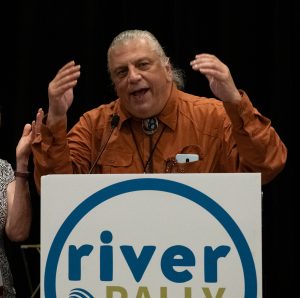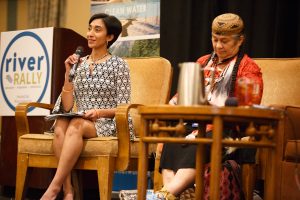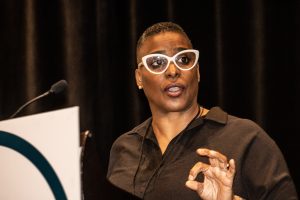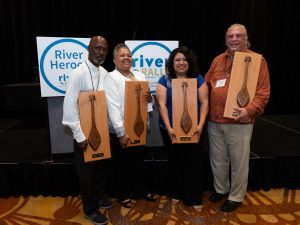Beyond Equity: The 2019 River Rally
At the moment he ascended to the podium, James Rasmussen wasn’t exactly certain what he was going to say. A capacity crowd was gathered in the ballroom of the Westin Cleveland Downtown Hotel for the annual River Rally conference. Among the honorees nominated by his peers to receive a 2019 River Hero Award, he walked up to the microphone with an air of apprehension.

James Rasmussen at the River Heroes Award ceremony. Photo by Benjamin Colon.
“I was more than apprehensive,” Rasmussen told me in an interview. “As of that morning I was going to refuse to accept it.”
At least a few members of the staff and board of directors at River Network were concerned over the implications and consequences of a nationally recognized environmental activist declining to receive its most prestigious token of esteem. The awards, miniature handcrafted canoe paddles, are meant to recognize and acknowledge the hard work of men and women who make extraordinary efforts at the local level to protect the waters and rivers of our nation. Rasmussen, the superfund manager of the Duwamish River Cleanup Coalition, has been a tireless steward of the biotic community of fish, wildlife and humanity near his home in Seattle for more than 30 years. But as the executive director of the Duwamish Tribe Advisory Council he questions the commitment of mostly white environmental conservation groups, like River Network, to serve the best interests of Native Americans and other people of color. As Rasmussen uttered his first words, no one seemed to know what would happen next.
“We had a lot of hard conversations earlier in the day,” said River Network executive director Nicole Silk. “Everyone was pretty much holding their breath.”
Even as an outside observer I could sense the apparent tension in the room. Relatively new in my acquaintance with River Network I was aware of the organization’s efforts to better address the cultural needs and priorities of its members who serve marginalized communities. Having reported on similar ambitions among other environmental advocacy groups in the recent past, I’m pretty sensitive to the emotionally charged atmosphere that inevitably surrounds the complex and complicated topics of equity, diversity and inclusion in the conscientious management of natural land and water resources. Despite its best intentions, however, River Network, like any human enterprise, will just as inevitably make mistakes.
A year ago River Rally was held near the town of Lake Tahoe, California. The location was selected for its natural beauty, eco-friendly facilities and its proximity to the Truckee River. But the organizers neglected to take into account the problematic name of the venue, The Resort at Squaw Creek.
“We had a number of Native Americans and advocates at the conference with us who called us out,” Silk said. “How could we possibly hold River Rally at a place that has in its name a derogatory term for Native Americans?”
Though the offense was unintended, Native people at the Conference felt aggrieved. Leading up to the River Heroes Award ceremony a petition was circulated to criticize River Network’s staff and board members for their choice. Rather than offer a justification for their oversight, Silk took a different tack.
“We don’t defend. We apologize and we own it,” she said. “We began the award ceremony with an apology that was heartfelt and real. In a way we modeled the behavior that we have been talking about for the rest of our community.”

River Network board member Jumana Vasi and plenary speaker Chief Caleen Sisk at River Rally 2018. Photo by Emily Tidwell.
Since 2014, River Network has made a concerted effort to achieve equity, diversity and inclusion throughout its organization. If environmental advocacy groups are going to remain culturally relevant in a world that is beginning to reflect the values of a population that includes more and more people of color, they must begin to address the specific needs and concerns of each community they aim to serve. It’s estimated that by the year 2045 a majority of the US population will be non-white. What would happen if in a generation the movement to protect the rivers of North America fails to reflect the diversity of society as a whole?
River Network aspires to bridge the disparities of both advocacy for and access to water resources among communities of color. The group was motivated through the findings of a 2014 report entitled, “The State of Diversity in Environmental Organizations: Mainstream NGOs, Foundations & Government Agencies.” Written by Dr. Dorceta E. Taylor, a University of Michigan sociologist known for her work on both environmental justice and racism in the environmental movement, the report details the low rates at which people of color are represented among the ranks of environmental non-governmental organizations, including River Network and the thousands of groups they connect with and engage across the United States.
“The composition of environmental organizations and agencies has not broken the 12% to 16% green ceiling that has been in place for decades,” Silk wrote in a 2015 River Voices article. “And the situation is even more extreme at the board level with only 4.6% being people of color.”
As non-white people currently constitute 40 percent of the American public, these statistics reveal that environmental groups are out of step with the cultural mainstream. This so-called “green ceiling” will only be more problematic when people of color become the majority population. Organizations like River Network are beginning to understand and embrace the importance of EDI to their long-term success and do what they can to change the future. The group has committed to training its staff and board members to recognize both explicit and implicit cultural biases that limit the participation of under-represented members of the community at large. Jumana Vasi, a board member and chairwoman of the equity, diversity and inclusion committee, says River Network aims to start from within by recruiting people of color to become part of its leadership. As one of only a handful of people of color on the board, however, she admits that progress is slow. But Vasi says their continuing efforts toward equity are imperative to fulfill the primary mission of the Network: to protect the integrity of America’s rivers.
“Water is the place where inequity really presents itself. It’s life and death,” Vasi said. “When you have an equity problem on water it’s not a marginal or superficial issue. It’s critical.”

Keesha Gaskins-Nathan delivering River Rally keynote “Water and Democracy in the United States.” Photo by James Edward Mills.
In the spirit of bringing more people of color into the discussion around protecting our water resources, the 2019 River Rally brought together participants across a broad spectrum. With an inspiring keynote address on Saturday morning from Keesha Gaskins-Nathan, the director of the Democratic Practice Program at the Rockefeller Brothers Fund, the conference set a tone that seemed to empower everyone in attendance to imagine the prospects of substantive change. In her opening remarks Gaskins-Nathan impressed upon the audience their obligation to directly address the needs of communities, most often communities of color, that are at risk of losing their water sovereignty, the right to safe and accessible drinking water. She insists that every organization working on river and watershed protection must expand their lens to protect the natural water resources of all people, especially those who are described as vulnerable.
“These communities are not vulnerable,” she said with passion. “They are targeted.”
Areas populated by those who have been systematically disenfranchised will inevitably be subjected to abuse by those in power. These communities are indeed targeted for natural resource extraction or waste disposal due to their inability to resist through social or political influence. When it comes to water that typically means biological contamination, pollution or scarcity. To suggest that these communities are vulnerable implies that it is up to them to strengthen their resolve to change their life circumstances. But Gaskins-Nathan believes that equity can be achieved by working together to change the system.
“We can change it, but we can’t do it alone,” she said in an interview. “It requires collective action, collective movement and organizing to functionally change how these systems impact our communities so they can become the self-determinative places we know they are.”
Through the practice of EDI principles organizations connected through River Network can make this change possible. Brenda Coley, co-director of Milwaukee Water Commons, said in a panel discussion that she wants her non-profit to go beyond mere diversity and inclusion to achieve something greater: a truly multi-racial institution.
“People of color are often asked to diversify a White Center,” she said. “But if we could take that center and bring it to the margins where the rest us of are then we can all, including white people, work together to build something new in the center. I think that would be really powerful. Because what we have now is not working. I think having a multiracial organization is really what we’re going to need to go into the next century.”

2019 River Heroes (L-R): Dennis Chestnut, Monica Lewis-Patrick, San Juana Olivares, James Rasmussen. Photo by Benjamin Colon.
Through the leadership of River Network a broad coalition of advocates is slowly emerging to better represent the American people as a whole. For the first time ever this year’s River Hero Award recipients were all people of color. The honorees include Dennis Chestnut, Executive Director of Groundwork Anacostia River D.C.; Monica Lewis Patrick, President of We the People of Detroit; and San Juana Olivares, President of the Genesee County Hispanic and Latino Collaborative. Kevin Jeffery, a graduate student at the University of Texas at Austin School of Architecture received the new Emerging Leader Award.
With a shared vision of the future, James Rasmussen addressed the River Rally audience to accept his River Hero Award. Inspired by the morning address from Keesha Gaskins-Nathan, despite his apprehension, he expressed a profound belief that only through the collective efforts of River Network and its member organizations, regardless of race, ethnicity or socioeconomic status, can sustainable environmental protection on America’s rivers be achieved.
“People, I want you to understand one thing. We work in the bottom of your watersheds, right where the cities are and where it goes into the ocean,” he said. “Lot of you work in the top of the watershed. IT’S ALL WATER. We have things we can teach you. You have things that you can teach us. We need to work together to make this organization more powerful moving into the future.”





[…] This story appears in the July issue of The River Network Blog […]